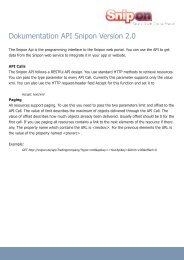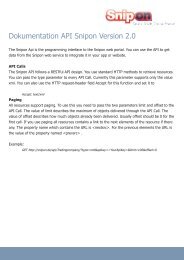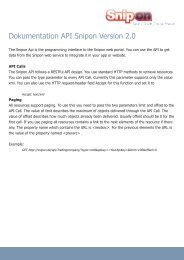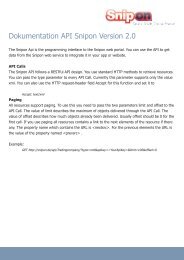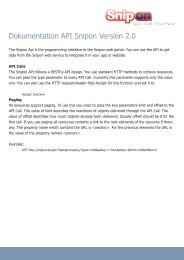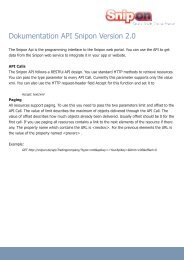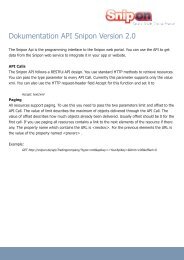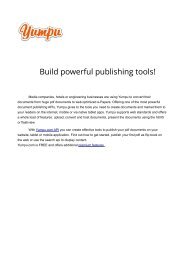test_pdf.pdf
Create successful ePaper yourself
Turn your PDF publications into a flip-book with our unique Google optimized e-Paper software.
ADDRESSING<br />
FUTURE<br />
ARMS<br />
CONTROL<br />
AND SECURITY<br />
PROBLEMS<br />
over this line, over the MTCR threshold, are not just ballistic missiles. They are rockets of any kind that can deliver<br />
500 kilograms to 300 kilometers, including space-launch vehicles and scientific sounding rockets. This was very<br />
difficult to get the seven nations, the United States and the rest of the Western economic summit nations, to accept<br />
when we negotiated this regime in the mid-1980s—the idea that you put identical controls on military ballistic<br />
missiles and on civilian space-launch vehicles and scientific sounding rockets. But it was absolutely necessary in<br />
order to have a strong, unambiguous line.<br />
The other items controlled are entire unmanned air vehicles, whatever they are called, if they have that range<br />
and payload capability I described. Cruise missiles, unmanned air vehicles, reconnaissance drones, target drones.<br />
If they have that capability, they are subject to a strong presumption of export denial.<br />
Now there are good missiles and bad missiles in the world. Some defensive missiles are very good, and so<br />
we needed some way of defining what it was that the regime was going to target with its export controls. That line<br />
is the essence of the MTCR. To begin to fuzz that line is to begin to weaken our ability to control the spread of<br />
missiles.<br />
Let me mention the second policy that could be the basis for future activities. I’ll go back to the MTCR in a bit.<br />
The second policy is something that came up a little over a year ago, came to fruition a little over a year ago, that<br />
was put together by the 33 governments that are now members of the MTCR. This new policy is called the<br />
International Code of Conduct, or the ICOC. Its purpose was to bring the have-nots in on nonproliferation of<br />
missiles, not just to have it be a supplier export control regime. The idea of an international code of conduct was<br />
developed in the late years of the Clinton administration and then implemented in the Bush administration. So it<br />
is a bipartisan concept. It has succeeded in more than tripling the number of governments subscribing to a missile<br />
nonproliferation policy. Compared to the 33 members of the MTCR, there are over 100 members of the ICOC now.<br />
The la<strong>test</strong> countries to subscribe of which I am aware are Eritrea, Liechtenstein, and Tonga.<br />
The ICOC is very loosely written compared to the MTCR, and therein lies the problem. Unlike the MTCR, the<br />
ICOC creates a distinction between space-launch vehicles and ballistic missiles. It has much weaker restraints on<br />
space-launch vehicles, even though they are interchangeable with ballistic missiles. That was necessary to make<br />
this a policy that a large number of nations such as Eritrea, Liechtenstein, and Tonga could accept. Unlike the<br />
MTCR, the ICOC prescribes no restraints whatsoever on cruise missiles. It is dedicated entirely to ballistic missiles,<br />
which is something that political people seem to think of when they think of missiles. Unlike the MTCR, the<br />
ICOC vaguely endorses “cooperative programs” that could actually lead to using ballistic missile programs as<br />
bargaining chips to secure other advantages.<br />
Unlike the MTCR, the ICOC finds various ways to work with ballistic missile programs by having “programs<br />
of transparency.” There is some fear that these looser rules in the ICOC will lead some countries to venueshop<br />
and say, well, maybe we haven’t restrained ourselves according to the guidelines of the MTCR, but we have<br />
acted within the guidelines of the ICOC, so what’s the problem?<br />
The ICOC took something like four years to negotiate, about the same as the MTCR, and it diverted staff<br />
resources in countries where sometimes only one person works on missile, nuclear, chemical and biological<br />
nonproliferation. It diverted these resources from the business of export control.<br />
In short, there is a question whether an approach like the ICOC has sacrificed nonproliferation policy in the<br />
name of cosmetic advantages. Now this question about cosmetics versus real nonproliferation becomes even<br />
more compelling when we look at the third alternative for moving along in the future, and that’s a proposal that<br />
was promoted by Iran in the United Nations and is now taken up by some other governments and the United<br />
Nations staff to see if it’s possible to negotiate a binding international treaty against missile proliferation, a sort<br />
of missile NPT.<br />
I think we’ve already seen from the ICOC experience that bringing the haves and the have-nots together in<br />
some missile nonproliferation policy is going to result in some serious compromises. In fact, the history of these<br />
kinds of negotiations is that you almost invariably need a sweetener in order to bring the have-nots along, and<br />
most people who have proposed ballistic missile nonproliferation treaties have the identical idea about what the<br />
sweetener should be. The sweetener in their view should be the sharing of space-launch vehicle technology with<br />
countries that agree to forgo ballistic missiles. Not much of a nonproliferation policy. You are actually offering the<br />
rocket technology to the countries, the capability in return for a statement about intentions. Maybe not a good way<br />
to go, but one that is definitely in the hopper for the future.<br />
The fourth approach has already been mentioned this morning, and that’s the Proliferation Security Initiative,<br />
which was announced by the president less than a year ago. Under Secretary of State John Bolton will be in<br />
Russia this week, seeing if he can get the Russians to join this policy. It complements export controls very strongly<br />
by creating an environment in which, if you can somehow evade controls of exports and get the item you want on<br />
the high seas or in the air going toward you, it might just be intercepted anyway. So there’s another barrier to<br />
56<br />
56



